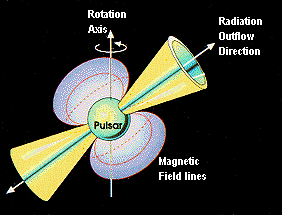
Depiction of NASA's NuSTAR Orbiter with which the latest ULX was discovered.
Consider an x-ray source of 10 Ms (ten solar masses), or three times the theoretical maximum for a neutron star mass. Can we not say that the former object is more likely to be an ultraluminous x-ray source (ULX) than the latter? Let's back track and see why this became an issue, and a question.
As I've noted in previous posts over the years, we do not detect black holes directly but indirectly, Thus, in the case of macro-scale black holes (as opposed to quantum scale Hawking mini- black holes), we observe them indirectly as a members of binary (double) star systems, in order to infer their presence. In this situation x-rays are given off from the companion star’s infalling material - from its gaseous layers As the extraneous matter is severely compressed by the black hole's gravity, it gives off the characteristic x-rays.
A new insight arose when it was realized that these x-rays can exert outward radiation pressure on the infalling material. Then - at some critical value (the "Eddington limit") the radiation pressure and gravitational pressures balance. Thereby the further infall- because it must disturb this balance, ramps up the luminosity of the object.
In the 1980s, astrophysicists discovered point like x-ray sources with luminosities that exceeded the Eddington limit for neutron stars by at least an order of magnitude. These were dubbed ultraluminous x-ray sources and were presumed to harbor massive (e.g. 10 Ms ) black holes, as opposed to neutron stars. But this assumption had to be rejected by 2014 when the first neutron star ULX was discovered.
A fluke? No, given a second ULX has been discovered which displays a coherently pulse x-ray emission, in other words which could only originate from a neutron star. (Which is why they are also referred to as "pulsars" because of the very rapid radio and x-ray emission signal). The pulsations, also, from an astrophysical perspective, require separation between the rotation axis and magnetic poles, i..e. an actual surface which black holes lack.
In the case of the new ULX, designated NGC 7793P13 or "P13", 0. 42s pulsations have been found by Felix Furst of Caltech and his colleagues, and published in The Astrophysical Journal (831, L14, 2016). The full paper can be found here:
http://authors.library.caltech.edu/71748/1/F%C3%BCrst_2016_ApJL_831_L14.pdf

However, in P13's case the field strength implied by the luminosity is so high that the magnetic funnel must be extremely narrow. Such a geometry would yield sharply peaked ('burst') pulses but as it turns out P13's pulses are sinusoidal.
So despite the author's attempts, one must acknowledge that the exact manner by which the two neutron ULX sources evade the Eddington limit must remain a mystery.
No comments:
Post a Comment